At a Glance
Summary
I was extremely impressed by the comprehensiveness of the report generated by Embark. It was interesting to discover that my dog Cookie was descended from the Coton de Tulear – a breed I’d never heard of before! – and I had my suspicions confirmed that he was, more or less, half poodle.
It was a relief to see that Cookie did not test positive for any of the 165 health conditions they looked for, and so the fact that there was little to see in this section was really a blessing! There was a slight chance of him having a low enzyme activity that could affect his liver, and I was glad that I would be able to share this information with my vet if it ever became necessary.
Contributing to Embark’s research questions was really enjoyable, and also gave me more tailored information I could use to tweak Cookie’s diet and exercise to what was best for his genetics, weight, and activity level. I was happy to know that my answers would help aid research that would benefit other dogs, and allow Embark to continue to hone and expand their reports!
Full Review
Embark was founded in 2015 by Ryan and Adam Boyko, who have travelled the world learning as much about dogs and canine DNA as possible. Their research has contributed to a number of scientific studies, and Adam has co-authored over 40 peer-reviewed scientific papers.
Embark aims to empower dog owners with knowledge of their dog’s breed, ancestry, traits and health. Their DNA health test screens for more than 160 genetic conditions, allowing owners to prepare for potential complications in their dog’s future.
Product Expectations
From the Embark website, I learned that the test would require a cheek swab sample, and would look at over 200 thousand genetic markers, and test for more than 160 genetic health traits, as well as other traits like coat color and type.
Their dog DNA test would look for genetic markers belonging to over 250 breeds, covering over 98% of dogs in America. I suspected my Cookie has some poodle DNA, since he has a crazy fluffy coat, and sometimes wanders about on his hindlegs for no apparent reason, which I’d discovered is something some poodles are able to do.
I discovered that the Embark lab is CLIA-certified, meaning that it meets the standards required for performing diagnostic tests on human samples, which I thought was pretty impressive, as not all human genetic testing laboratories meet these standards!
There was information on the website about how to take a cheek swab sample (which, though painless, might be a bit confusing for your dog!), which would also be included in the instructions with the kit.
If I consented, my dog’s genetic data would be anonymized and used in aggregated research. I saw no reason to opt out of this, since there wouldn’t be any way of identifying my dog, and it would help contribute to research into canine health and disease, which would benefit dogs everywhere.
I imagined that it could be upsetting to discover that your dog has a genetic disease. Luckily, Embark had this covered. There was an online customer service form, and a live chat, as well as a customer service email. If I wanted to discuss my results, I could arrange a telephone appointment with one of their scientists or veterinarians, or my own veterinarian.
Interestingly, I could download my dog’s raw data once my results were available, though what I’d do with it I had no idea!
Lastly, there were samples of what would be included in the health, breed and traits reports, which looked pretty comprehensive! The turnaround time seemed very quick: once I returned my dog’s DNA sample to the lab, my results would be ready in three to seven weeks.
Ordering Experience
Ordering through the Embark website was easy. There was a shipping charge for international orders, but shipping within the US was free, as was return postage.
I was required to give a phone number, an email, a street address, and credit/debit card details. Gift options were available.
I received my dog’s DNA kit within a few business days. The box looked like the one I’d seen on the site, and was colorful and contained instructions about how to register online (it was important to register with the kit number before returning!), and how to take a cheek swab sample from my dog.
Luckily, I didn’t have to jam the swab straight in his mouth, which I thought he might object to. It was pretty easy to swab Cookie’s cheek, though he was curious about just what I was doing.
The kit also included a little metal dog tag. This had a web address on it, and a phone number. When I later looked up the web address, I found that it led to a profile page for my dog, with the option to contact his owner (me) if he had been found.
Registering the kit was straightforward. There was a questionnaire, where I provided some information about my dog, including name and gender. I could also upload a profile picture if I wanted. They asked me for something fun or unique about my dog, and I mentioned about how he stands on his back legs. They asked if the dog was neutered, and for the breed type (“Mixed Breed” was an option; if the dog was purebred, the content could be customized accordingly, and any discrepancies between genetic breed and reported breed would be highlighted). I could also give his date of birth, if known, or an estimated date.
In the FAQs, I’d read that the liquid in the DNA collection tube would preserve my dog’s DNA sample for many months, and so I wasn’t worried about it lasting the journey back to the lab. I sealed the sample in the provided envelope, and mailed it back.
About a week later, I received an email from Embark saying that my dog’s sample had arrived at the lab. A couple of weeks after, I had another email, saying that my dog’s DNA was being genotyped, and that they expected my results to be ready in two to five weeks. I thought the update was a nice touch, since DNA tests tend to take a while, and it was nice to feel they hadn’t forgotten me!
The Results
About four weeks later, I received an email telling me Cookie’s results were ready. This contained a link to my online account, where I could access information on Cookie’s breed mix, health, and traits, and answer questions about his behavior, diet, allergies and so on to receive more personalized information and contribute to research.
I could also print the report as a PDF, which included a breed certificate.
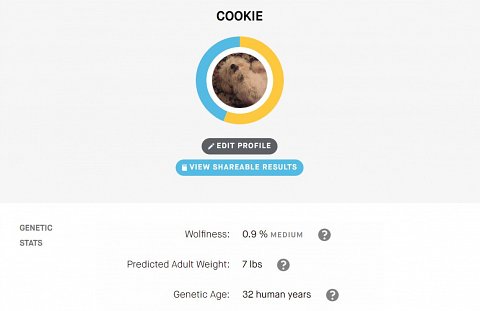
Cookie’s results dashboard.
As you can see, they had estimated Cookie’s “wolfiness”, adult weight, and genetic age. Clicking on the little question marks gave me more information, and so I learned that “wolfiness” was to do with how many genetic markers Cookie shared with wolves. Most dogs had Wolfiness Scores of 1% or less, and so Cookie – small and harmless as he was – had about medium wolfiness.
Cookie’s predicted weight was about seven pounds, which he is more or less. I read that they used breed mix, genes known to influence weight, and the dog’s sex to determine their likely weight – assuming the dog isn’t overweight!
My dog’s predicted age was 32 human years. Again, this was calculated based on genetics, breed mix, and sex. Like humans, female dogs tend to live longer.
Results Section: Breed and Ancestry
I first went to the breed section, since I was keen to learn what breeds had made Cookie the little white fluffball he is. As I’d suspected, Cookie was almost half poodle (44%), but 56% Coton de Tulear, a breed I’d never heard of!
Clicking the name of the breed took me to an information page about it. I learned that the Coton de Tulear is known as the “Royal Dog of Madagascar”, a sociable little dog that makes for a good companion and a low maintenance houseguest. From the picture, I saw the breed resembled a Maltese, and looked like a straighter-haired version of Cookie.
I could browse the profiles of other Coton de Tulears and poodles (both purebred and mixed), and see how much breed ancestry they had in common with Cookie. His highest matches were Coton de Tulears, with whom he had a Mix Match of 56 out of 100.
I had a look at Cookie’s family tree (shown below).
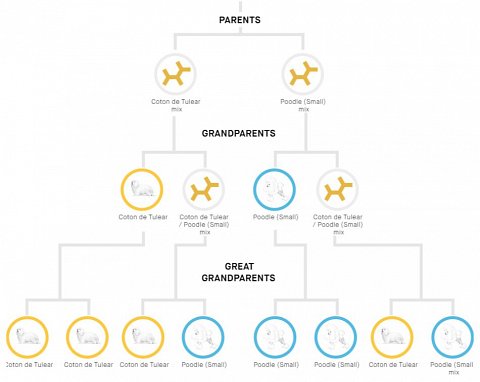
Cookie’s predicted family tree.
He had a bit of an odd split, being a bit more Coton de Tulear than miniature/toy poodle. His predicted family tree showed a complicated mix of poodles and Cotons going back to his great-grandparents. It seemed a bit weird that anyone had deliberately bred poodles and Cotons together over two to three generations, or that they had intermingled so many times by accident!
A note from Embark said that they used algorithms to generate the most likely family tree to explain Cookie’s breed mix, but that it may not be the only possible one.
The Breed Families subsection gave short overviews of the Coton de Tulear and Poodle (Small). (“Small” encompassed both toy and miniature varieties, and so I gathered that they were unable – as yet – to distinguish between these.)
This section showed the cousin breeds for each breed. Both had Maltese and Havanese as cousin breeds. The Poodle (Small) was also related to the Poodle (Standard) and Bichon Frise.

The Coton de Tulear.
Results Section: Breed and Ancestry – Haplotypes
Next, I could view Cookie’s maternal haplotype. I discovered that he belonged to haplogroup B1, which I read was the second most common maternal lineage in breeds originating in Europe or America. About half of Toy Poodles belong to this line, which could suggest that Cookie’s mum belonged (at least partly) to this breed.
Cookie’s maternal haplotype – a more specific group – was B82, which occurs most frequently in mixed breed dogs. As the haplotype DNA is inherited wholly from the mother, this suggested that Cookie’s mother was mixed breed herself: a blend of Coton and poodle, most likely!
Cookie’s paternal haplogroup was A1a, descended from the first wolves that became the original dogs in Central Asia around 15,000 years ago. This haplogroup is now incredibly widespread, and can be found in Polynesian village dogs, and purebreds and mixed breeds all around the globe, including German Shepherds, Golden Retrievers, Pugs, Border Collies, and many others.
Cookie’s haplotype was H1a.7/H1a.8. This haplotype occurred most commonly in Labrador Retrievers, Vizslas, and English Springer Spaniels – though I did see a Standard Poodle amongst the profiles of dogs with this haplotype!
Results Section: Health
Fortunately, the health section for Cookie wasn’t actually that interesting, since he was clear of all 165 genetic diseases and traits they tested for.
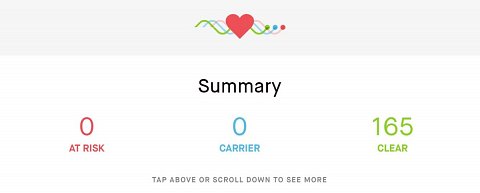
Cookie’s health summary.
There was one condition for which Cookie was at a slight risk for, which was to do with his “alanine aminotransferase activity” (or ALT activity). I clicked on this result, and was taken to an information page, where I learned that he had one copy of the “A” variant in his GPT gene, which has been associated with low ALT activity, which can affect liver health.
Cookie’s risk was given as “low normal”, which didn’t strike me as particularly worrying. However, if he were to develop liver problems later, I would be able to show this result to his vet (there were options to easily share the health report with a veterinarian), so that we could know more quickly if this was the underlying cause.
Results Section: Advanced and Traits
Next I went to the “Advanced” tab, which was intended for people with a deeper understanding of genetics, but I reckoned I could give it a go!
The first subsection was “Inbreeding by Chromosome”, which showed the chromosome segments which revealed inbreeding. Since Cookie is mixed breed, his inbreeding percentage was lower than most purebreds. Scrolling down, I found an “Inbreeding Coefficient”, which measured the proportion of his genome where the genes on the mother’s side had identical descent to those on the father’s. Cookie’s inbreeding coefficient was 5%, which sounds pretty high, but from their graph I saw that most purebreds were about 20% inbred!
I could also view Cookie’s breed mix by chromosome. Unlike humans, I saw that dogs have thirty-six pairs of chromosomes: half from the mother, and half from the father.
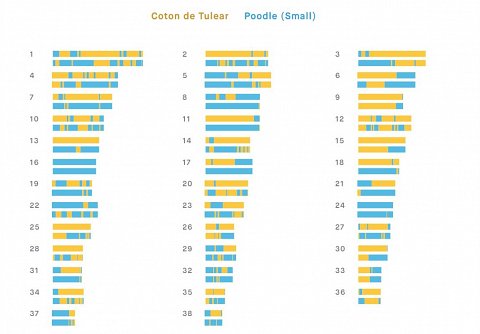
My dog’s chromosomal breed mix.
Yellow segments indicated the genes Cookie had inherited from his Coton de Tulear forebears, while blue segments were inherited from his poodle ancestors. I could just about tell that Cookie has inherited slightly more segments from his Coton de Tulear family.
The “Traits” section was a bit more complicated, and I understood why Embark had thought to mention that this bit was really only for geneticists, amateur or otherwise. But it was impressive that they had been able to extrapolate so much from Cookie’s genes!
The traits included things like coat color and fur texture, and gave the genes and genetic variants they had looked at, as well as the studies they had referenced for their results. It was a little confusing for the layman, since the genetics of a dog’s appearance weren’t straightforward, and there were multiple genes that contributed to fur type and color, as well as size.
Of course, it was easy to see the accuracy of some of these genetic traits results. My dog didn’t have the variants for a “Natural Bobtail”, and you can tell by looking at him that he has a long tail! Neither did he have both the variants needed for brachycephaly: the “smushed” face shared by bulldogs and pugs.
They also tested for a genetic variant associated with the ability to adapt to high altitude, but Cookie didn’t have any copies of this, which is usually found in dogs bred in high altitude areas, like the Tibetan Mastiff.
Results Section: Research
In the “Research” section, I found I could contribute to assessments and surveys about Cookie’s health and behavior. Some of these would provide tailored recommendations, while all would contribute to research into canine health and wellness.
Their “Nutrition and Exercise” assessment asked a series of questions about my dog’s diet, appearance (in terms of weight), and how much exercise he got. Based on my answers and his genetic profile, Embark generated suggestions for how much I should be feeding and exercising him.
There was also an allergy assessment, which would help their researchers look for links between genetics and canine allergies. Other surveys included things like dental health, behavior, medical history, and physical traits. All this volunteer information would help reveal more about the complexities of doggy genetics, and help to improve Embark’s results, as well as aid research that could benefit dogs everywhere.
Summary
I was extremely impressed by the comprehensiveness of the report generated by Embark. It was interesting to discover that my dog Cookie was descended from the Coton de Tulear – a breed I’d never heard of before! – and I had my suspicions confirmed that he was, more or less, half poodle.
It was a relief to see that Cookie did not test positive for any of the 165 health conditions they looked for, and so the fact that there was little to see in this section was really a blessing! There was a slight chance of him having a low enzyme activity that could affect his liver, and I was glad that I would be able to share this information with my vet if it ever became necessary.
Contributing to Embark’s research questions was really enjoyable, and also gave me more tailored information I could use to tweak Cookie’s diet and exercise to what was best for his genetics, weight, and activity level. I was happy to know that my answers would help aid research that would benefit other dogs, and allow Embark to continue to hone and expand their reports!
Please note we were invited to take this test free of charge.
At a Glance
Summary
In summary, I really enjoyed using Embark’s Dog DNA test, and it was reassuring to find out that Harley doesn’t have a high risk of developing any of the wide range of diseases tested for. The breed ancestry section would be most interesting for someone testing a mixed breed dog, but this was less interesting as Harley is a purebred. Still, it provided valuable insights into Harley’s characteristics.
Considering the wide range of conditions and breeds it covers, this test was great value for money. It provides a comprehensive combination of health and ancestry results that no other provider currently offers.
Full Review
By screening for 164 health conditions, and for genetic markers that can determine 150 of the 187 American Kennel Club (AKC) breeds, Embark’s Dog DNA test provides insights into your dog’s wellbeing and ancestry.
There are an increasing number of dog DNA tests on the market, but Embark offers one with an impressively comprehensive list of breeds and diseases, and is quite unusual in providing health and ancestry results as part of the same test. I was therefore excited to see how it would compare when I tested my Portuguese Pointer, Harley.
Product expectations
The Embark website offered a lot of information on what to expect from their product. It was clear from the outset that I’d receive results in two main areas: Harley’s health and her breed ancestry. The website highlighted other aspects that would be in the report, such as appearance, behavior and information for vets. In addition to outlining what would be included in the results, there was a clear description of how sample collection would work, as well as previews of the report itself. This was really helpful as it reassured me that the procedure would be painless for Harley, and it was good to have an idea of what to expect from the results.
There was also a section that compared the Embark DNA test with dog DNA tests offered by other providers. It compared generally, rather than directly comparing its products to those offered by specific companies, but it was hard not to be impressed with the differences in the number of genetic markers tested for (200,000 vs 2,000), and the number of health conditions screened for (160+) in one test. I do know that other companies, for example Wisdom Panel, offer breed identification tests that include a few more AKC-recognized breeds in their analysis. However, Embark can identify 98% of AKC-recognized breeds, and as they combine both breed information and a health analysis, it compares well in what it offers.
Ordering experience
Ordering the Embark Dog DNA test was very straightforward, and I was relieved to find that, although the lab is located in the US, I only had to pay an extra $10 (about £7.50) for shipping to the UK, and delivery to US addresses is free. There was also the option to pay in 4 monthly instalments rather than all of it upfront. This was a useful choice to have, as although I think the test offers value for money, it is quite a lot of money to pay all at once.
I received my test kit two days later, which was surprisingly quick considering that Embark is based in the US. It took me a while to pluck up the courage to try and pin (the very hyperactive) Harley down to take the sample. But I needn’t have worried, as it took less than 60 seconds to swab her mouth, which I then put in the collection tube provided. I activated my kit online, sent my samples off in the prepaid return envelope and waited for the results.
Results
Two weeks after sending off Harley’s sample I received an email letting me know that it had reached the lab and was soon to be processed. This email felt really personal and provided extra information on how the DNA sample would be purified and analysed to produce the results. I also appreciated the assurance that my report would be available in 4-6 weeks.
I received my results via the ‘My Embark’ section of the website, which had been accessible since registering my kit, allowing me to check the progress of the test. The initial page showed ‘health results ready’ (the ‘Health’ section) and ‘non-health results ready’ (the ‘Summary’). Three other sections were also accessible: ‘Breed Ancestry’, ‘Genetic Passport’ and ‘Vet Report’.
Results section: Health results
I chose to look at Harley’s health results first. I was slightly nervous about what they might reveal, but wanted to find out any potential risks as soon as possible. Luckily, Harley received a clean genetic bill of health, which showed her to have a low risk of developing any of the conditions screened for. It also showed that she was not a carrier of any inherited disease-related genes, and that she is unlikely to suffer from the most common conditions that affect her breed. One of these conditions was ‘Multidrug Sensitivity’ (result shown below), which is caused by mutations in the MDR1 gene. This potentially fatal condition was highlighted when Embark was featured on The Today Show, so I was already aware that this was one of the main ones they feature in their results.
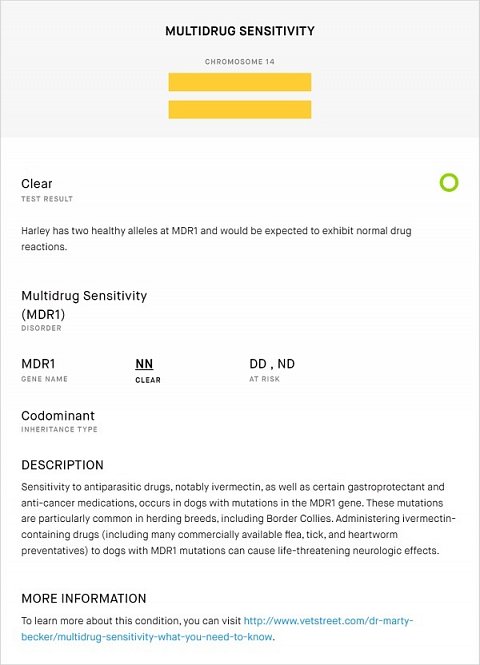
Harley’s Multidrug Sensitivity result.
When I clicked on the ‘Full Disease Test Panel’ results section, I was impressed by the amount of detail included in the description. Each condition listed included information about which gene was linked to the condition, and a diagrammatic representation of which chromosome that gene was found on was shown. In addition, despite the high level of detail in the descriptions, they were easy to digest and interesting to read. The level of detail given about each disease varied quite a lot from condition to condition. This was fine for me, as I was only reading them out of interest, but if Harley had been genetically likely to develop one, it may have been a bit frustrating to find that there was little or no information about it, especially considering how good the descriptions that were included were.
Results section: Categories and Vet Report
The health results were categorized by the different body parts that the conditions affect, an aspect that I thought worked really well (see below).
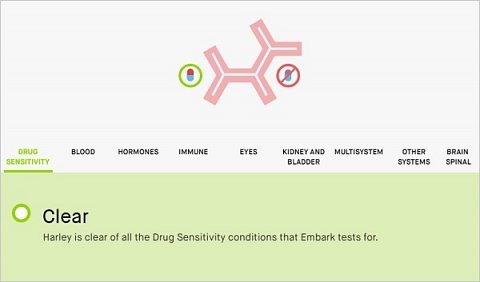
Harley’s Health results categories.
There were 17 categories in all: ‘Drug sensitivity’, ‘Blood’, ‘Hormones’, ‘Immune’, ‘Eyes’, ‘Kidney and Bladder’, ‘Multisystem’, ‘Other systems’, ‘Brain and Spinal Cord’, ‘Heart’, ‘Muscular’, ‘Metabolic’, ‘Gastro-intestinal’, ‘Liver’, ‘Neuromuscular’, ‘Skin’ and ‘Skeletal’. I did at first think that 17 was slightly excessive, and perhaps ‘Brain and Spinal Cord’ and ‘Neuromuscular’ could have shared a heading like ‘Nervous system’. But equally, these headings meant that the results were really easy to go through, and made scientific phrases such as ‘Progressive Retinal Atrophy (PRA) Rod-cone dysplasia, rcd1a’ more understandable than they may have been otherwise.
Another valuable aspect of the health results was the ‘Vet Report’, which Embark can email directly to your dog’s veterinarian or you can print yourself. This is probably the most practically useful part of the report. I initially thought that, as Harley is not at high risk of developing any of the diseases tested for, this would not be worth bothering my vet with. But the report explained that if she does get ill, then the fact that she’s not predisposed to certain diseases may reduce the time it takes to diagnose the problem, as the vet can quickly rule these out.
Results section: Breed Results
This section didn’t really provide any surprises, but confirmed that Harley is 100% Pointer. Although this meant that the family tree section (shown below) didn’t tell me anything I didn’t already know, I can see that this would be a really interesting, interactive feature if testing a mixed breed or rescue dog, especially if you had no previous idea of what breeds he/she was made up of.
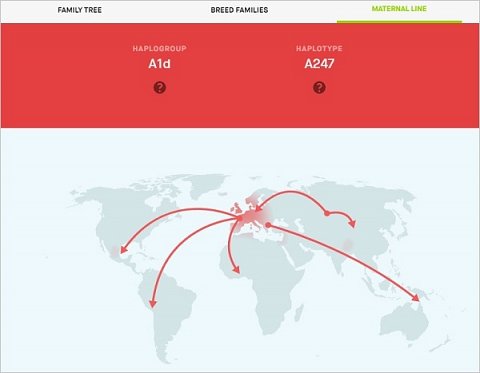
Harley’s Family Tree.
The only small improvement that could be made here would be to the non-highlighted side of the tree (you can swap between looking at maternal and paternal heritage). It’s so lightly outlined that it’s a bit difficult to see, especially the picture of the breed. Again, this wasn’t a particular problem with Harley’s results as I know she’s a purebred and therefore knew what to expect, but it might have become more of an issue if I’d wanted to explore a number of different breeds in a mixed breed family tree.
The part of the breed section I found most interesting was Harley’s ‘Maternal line’ results, which specified which maternal haplogroup she belonged to and her haplotype (shown below).
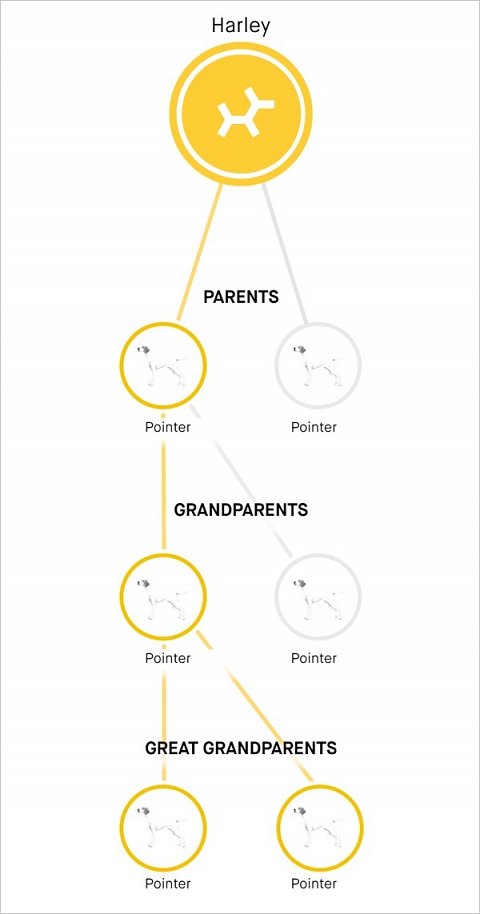
Harley’s maternal haplogroup and haplotype, and a map showing where her maternal ancestors originated.
These scientific terms were explained really clearly, and helped me to understand that these results showed where her earliest maternal ancestors had originated. As well as describing what haplogroup and haplotype meant, there were detailed descriptions about what Harley’s own maternal haplogroup (A1d) and haplotype (A247) meant about her heritage. It was particularly interesting to discover the other breeds that were part of Harley’s maternal haplogroup, such as Papillons, which I didn’t think had anything in common with Pointers!
In the other part of the Breed results section you are provided with a percentage of each breed in your dog (Harley was 100% Pointer), which again would probably have been more beneficial if receiving results for a mixed breed dog. However, the additional information that was provided about Harley’s breed was definitely worth looking at. I recognized several behavioral traits, particularly the ‘endless amount of energy’ (I think even that’s an understatement!). There was a lot to like in this section, from the ‘fun fact’ at the bottom, to the accessible public profiles of other pointers – these allowed me to compare Harley according to ‘Wolfiness’, weight and more. There were five related breeds listed as well, which was interesting, but it would have been even better had I been able to click on these breeds to find out more information about them.
Due to the fact that Embark cover 98% of AKC-recognized breeds, I was slightly disappointed that the test wasn’t sensitive enough to identify Harley specifically as a Portuguese Pointer, rather than just a Pointer. However, this is still a pretty rare breed, with only around 50 in the UK, with the breed only recognized by the AKC in 2005. I think I was just unlucky that Harley was one of only a few breeds that Embark doesn’t include in its analysis.
Results section: Genetic Passport
Harley got her own public profile (or ‘genetic passport’) as part of her results (see below).
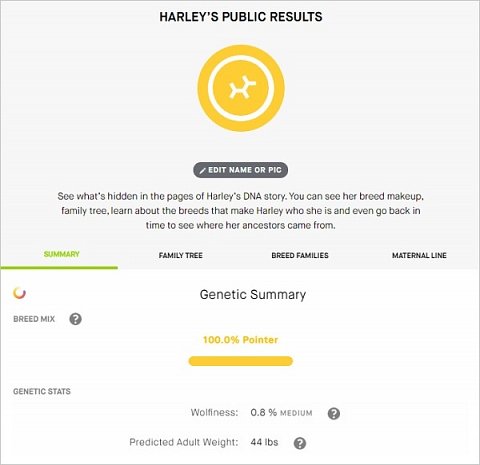
Harley’s Genetic Passport.
It was fun to see Harley’s ‘Wolfiness’ score, as well as her likely weight according to her genetics. She had medium-level wolfiness (0.8% - this seemed low to me until it was explained that very few dogs have over 1%) and although this doesn’t have much of an impact on her characteristics, it was an interesting addition. The genetic passport was set up in a readily shareable format, including all of Harley’s breed and ancestry results, whilst keeping her health results private.
Summary
In summary, I really enjoyed using Embark’s Dog DNA test, and it was reassuring to find out that Harley doesn’t have a high risk of developing any of the wide range of diseases tested for. The breed ancestry section would be most interesting for someone testing a mixed breed dog, but this was less interesting as Harley is a purebred. Still, it provided valuable insights into Harley’s characteristics.
Considering the wide range of conditions and breeds it covers, this test was great value for money. It provides a comprehensive combination of health and ancestry results that no other provider currently offers.
Please note that we were invited to take this test free of charge.
We are currently working on a few website changes that will be rolled out in the coming months. This will include highlighting the breed tree more clearly. We also will be adding clickable info on the related breeds in the future.
Our reference panel is also constantly growing. We have since added 10 more AKC registered breeds (we're up to 160!). We are also adding many non-AKC breeds to satisfy owners with unusual dogs.
We have also since added an "Embark Dogs" section to the breed results, where you can see the public profiles of other dogs with similar ancestry to yours.


